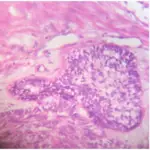Primary intraosseous squamous cell carcinoma is a rare epithelial odontogenic malignancy affecting the jaws and having no initial connection with oral mucosa and presumably developing from remnants of the odontogenic epithelium or from an odontogenic cyst or tumor.
What is the Pathology of Primary Intraosseous Squamous Cell Carcinoma?
The pathology of primary intraosseous squamous cell carcinoma is:
-Etiology: The cause of primary intraosseous squamous cell carcinoma is smoking, alcohol, and tobacco chewing.
-Genes involved: None.
-Pathogenesis: The sequence of events that lead to primary intraosseous squamous cell carcinoma originates from odontogenic cysts with a nonkeratinized epithelial lining, especially from radicular/residual and dentigerous cysts.
-Histology: The histology associated with primary intraosseous squamous cell carcinoma shows carcinoma of keratinocytes that infiltrates the dermis
How does Primary Intraosseous Squamous Cell Carcinoma Present?
Patients with primary intraosseous squamous cell carcinoma typically affect males and females present at the range of 30-60 years. The symptoms, features, and clinical findings associated with primary intraosseous squamous cell carcinoma include pain and swelling
How is Primary Intraosseous Squamous Cell Carcinoma Diagnosed?
Primary intraosseous squamous cell carcinoma is diagnosed based on clinical, radiologic, and pathologic correlation.
How is Primary Intraosseous Squamous Cell Carcinoma Treated?
Primary intraosseous squamous cell carcinoma is treated by surgical excision.
What is the Prognosis of Primary Intraosseous Squamous Cell Carcinoma?
The prognosis of primary intraosseous squamous cell carcinoma is poor.



